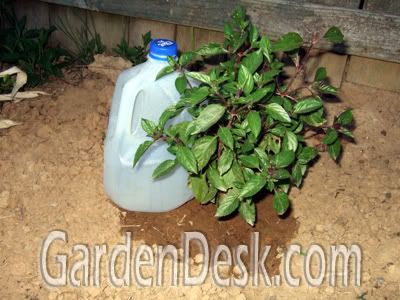Quick and Easy Watering Tip
We finally have gotten some rain here, so there is no longer an eminent danger of the garden plants dying. There still hasn't been enough rain for them to flourish so I will continue using the new watering technique that we came up with during this drought.

We used gallon milk or water jugs as slow drippers next to each plant. Here's how you do it:
Collect some jugs and rinse them out. Then poke eight or ten small holes in one side as low as possible. Use a straight pin instead of a nail so the holes will be very small. I've heard of people making the holes in the bottom of the jug, but I put them on the side down by the bottom. If you put the holes on the actual bottom, you have to make larger holes or they will be clogged by the soil.
Once your jug is ready, fill it with water and put the cap back on about half way. You can regulate how fast the water drips out by how tight you put the cap on. If you want it to drain quickly, leave the cap off.
I use this technique next to larger plants like tomatoes or peppers. In the above picture, the milk jug is watering a cinnamon basil plant. If you want to use dripping jugs between rows, you can poke holes in two opposite sides to water a part of each row at the same time. I like to keep the holes only on one side though, to control the water flow better.
The more jugs you have the better with this type of watering. Each morning, my wife or I take the hose out to the garden and fill up all of the jugs. We move them around to plants that were not watered the day before. Obviously, if you have a large garden, you can't water every plant this way, but since you fill up the jugs with your garden hose, you can then spray the other plants directly.
This slow drip method works better than directly spraying with a hose or sprinkler though. Since the water leaks out slowly, it is a more deep watering. The whole gallon of water makes it to the plant roots and no water is wasted.
If you are having a drought like we are here in Kentucky give the jug method a try!














4 comments:
we're deluged with rain here in England at the moment, but I'm certainly going to remember that one for when we're not.
A great tip that I've often used myself. I've found it especially good for tomatoes and courgettes. Like Dan I'm in England and no shortage of rain at the moment.
I have been using the same method for some years now, especially when I'm out of town for a longer period!
It works great!
Keep growing!
Well, for me, it was a new idea and I tried it out this weekend to keep some things moist in the heat of Pennsylvania.
thanks for the tip.
Post a Comment